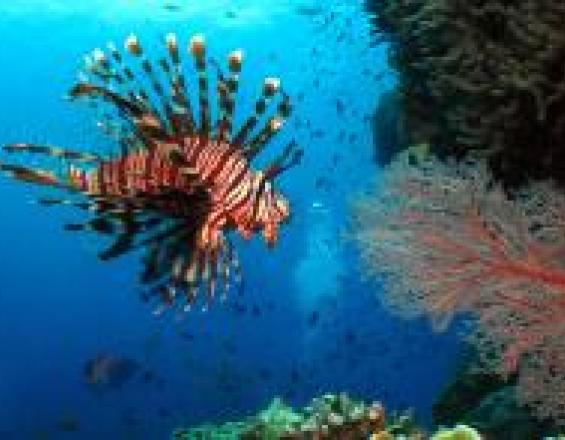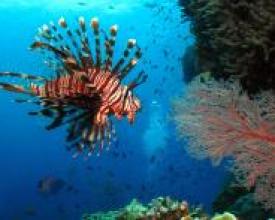
The Great Barrier Reef Strategic Assessment
Solution complète

Lionfish swimming around the Great Barrier Reef
IUCN Joao Letizio
The Great Barrier Reef (GBR) is an amazing natural treasure and one of the most precious ecosystems on Earth. In light of increasing pressures, and concerns raised by the World Heritage Committee on the impacts of development, the GBRMPA and other government agencies undertook a comprehensive strategic assessment, taking a look at the Reef's values, the threats to those values and what is needed to manage and protect them.
Dernière modification 28 Mar 2019
8576 Vues
Contexte
Challenges addressed
increasing pressures on the Great Barrier Reef
Emplacement
The Great Barrier Reef, Australia
Oceania
Traiter
Summary of the process
The findings of each assessment are presented in individual reports. The areas of overlap and joint management responsibility are addressed in both strategic assessments. The 25-year management program for the Authority (the Program Report) outlines how the Reef will be managed for the years ahead. It includes clear targets, cumulative impact guidelines and regional standards, restoration activities and an integrated monitoring and reporting program. For the first time, it considers the whole-of-Reef, with a focus on regional and local solutions. In addition, the outcomes of the strategic assessment are being used to develop the Reef 2050 Plan, in partnership by the Australian and Queensland governments and in close consultation with partners including the resources, ports, tourism, fishing, conservation and other sectors. This Plan will inform future development by drawing together the marine and coastal components of the comprehensive strategic assessment, providing an over-arching framework to guide protection and management of the GBR World Heritage Area from 2015 to 2050. It identified areas of action from the strategic assessments.
Building Blocks
Carry out assessments of the GBR region and coastal zone
The comprehensive strategic assessment included: an assessment of the GBR Region, which was led by the GBRMPA and examined the marine component; and an assessment of the GBR Coastal Zone, which was led by the Queensland Government and focused on the coastal areas adjacent to the Region. It used grading statements to standardise the assessments of the condition of values, impacts on values, management effectiveness and risk. The strategic assessment was based on the best available information as at June 2013, including scientific data, expert opinion, and Traditional Owner and stakeholder knowledge. Management effectiveness was independently assessed by a team of 3 assessors with comprehensive knowledge of protected area management. In addition, independent consultants peer reviewed the draft strategic assessment and program report
Enabling factors
These assessments were carried out under the Environment Protection and Biodiversity Act 1999, Australia’s central piece of environmental legislation. The strategic assessment process for the GBR Region was guided by terms of reference and aligned with the Queensland Government’s assessment for the adjacent coastal zone through a joint technical framework.
Lesson learned
The need for a clearly defined process outlining methods to be used and opportunities for stakeholder input. The merit in utilising a range of tools to assess impacts ranging from value-impact matrices, qualitative and quantitative models to understand cause and effect relationships and spatial mapping approaches (no one tool is perfect). The importance of considering the effects of impacts across a range of scales, both spatially and temporally, and the cumulative effect of multiple impacts on values. The necessity of taking into account how a ‘shifting baseline’ in the condition of values affects assessments of current condition and trend of values.
Public consultation on draft reports
Throughout the assessment process, the Authority consulted with its expert and community advisory groups. There were also opportunities for input from broader Traditional Owner and stakeholder groups through purpose-designed workshops and follow-up surveys, plus meetings with a range of interested organisations, groups and individuals. Public consultation on the draft strategic assessment and program reports for both the Region and the coastal zone took place over a three-month period from November 2013. Comments received through these processes were incorporated into final reports and detailed in supplementary reports.
Enabling factors
Contact solution provider for more information
Lesson learned
The importance of relying on best available information, including scientific data, expert opinion, and Traditional Owner and stakeholder knowledge.
Operationalising results of assessments in MPA management
The outcomes of the assessments are now being operationalised through a range of management tools and are informing development of a long-term sustainability plan (the Reef 2050 Plan) for the Great Barrier Reef World Heritage area.
Enabling factors
Contact solution provider for more information
Lesson learned
Contact solution provider for more information
Impacts
The assessment found that while the GBR World Heritage Area’s outstanding universal value remains largely intact, the overall health of reefs, especially in the southern two-thirds of the Region declined significantly. The strategic assessment concluded that managing the multiple impacts affecting the Reef requires a multi-pronged approach. It presented a series of recommended improvements to management arrangements that can be implemented by the GBRMPA and across local, state and national government programs. Given the size and complexity of the Reef, this involves balancing environmental protection with national, state and community interests. The assessment resulted in a 25-year management plan.
Beneficiaries
the Great Barrier Reef Marine Park Authority (GBRMPA)




